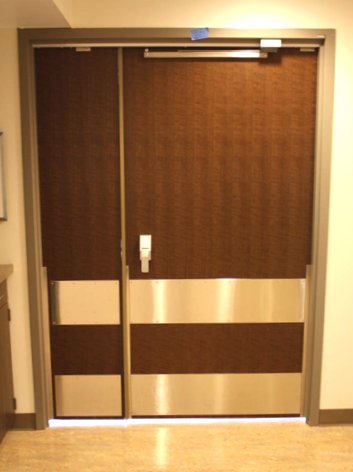 I haven’t been able to find an answer to this one!
I haven’t been able to find an answer to this one!
A stretcher plate is a protection plate most often used in hospitals, to protect the door from gurneys. What is the proper mounting height for a stretcher plate? I looked at some gurney specifications to find out the standard height, but they are adjustable so I’m not sure where the plate should go.
Anybody know?
I found this photo on Mid Central Door’s website. I’m hoping they don’t mind if I use it.
You need to login or register to bookmark/favorite this content.





Hospital beds/ surgery tables also
I once installed strectcher plates centered on the latching hardware, both sides of door, per owner direction, gov’t job.
Hi Lori> I once had a discussion with an archetect who was in the process of finishing a new building. They were putting sod down in the yard, not leaving any openings for sidewalks. I asked him about that and he said he puts off the side walks for a while, and then puts them where the students wear out the grass.
I apply same principle to protection plates in my facility. I buy all labled ones so I can use them anywhere, and then cover up the gouges.
Dave
I like Dave’s posting. Seems the hard way to do it. Why not spec a full armour plate and install one item instead of a kick plate and then the stretcher plate? This could all go before the hand over of the hospital.
The 2000 edition of NFPA 101 section 18.3.6.3.5: Life Safety Code limits the height protective plates can be installed to not more than 48 inches above the bottom of the door. This would be applicable to facilities subject to the CMS requirements (such as hospitals), unless they have been granted approval to use a later edition of NFPA 101. The 2012 edition for instance, allows plates unlimited in height.
Waiting for the gouges to appear made me wince a little bit. Once the door is damaged you really ought to replace. That might not be how things work in actual practice, but I can’t imagine the cost of a 48 inch high plate is significantly more than two other plates. I’d just spec that on high traffic doors to start. I have never seen the application in the photos, every application I’ve seen is either a 48 inch high plate, a 12-18 inch kick plate, or a full height plate.
It’s a per-job basis for me. It’s all contigent on the height of the gurney’s being used at the hospital.
I am supplying and installing “stretcher” plates in a hospital project and the consulting architects, VAMED, use these plates mounted at the center line of the lock to the center line of the plate. The plates are specially punched for the lock and 10 inches high. This protection plate is not for the stretchers at all, it is primarily used as a hard surface for “dirty hand” traffic and providing a surface that can be maintained easily.